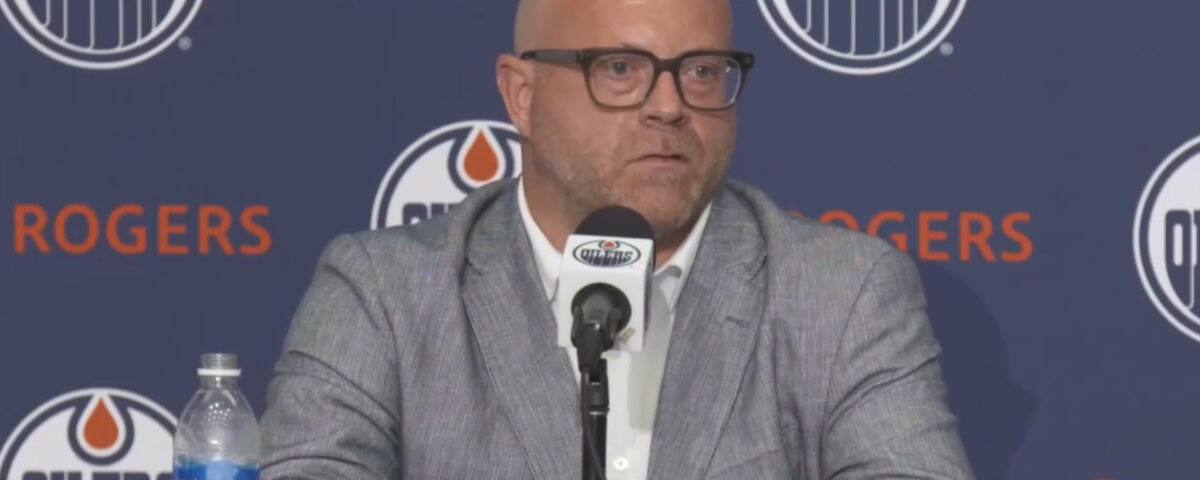

View the whole transcript of Tuesday’s media conference with Edmonton’s general manager and executive vice president of hockey operations discussing the team’s choice to turn down the forward and defenseman’s offer from the St. Louis Blues.
EDMONTON, Alberta – On Tuesday, Oilers General Manager and Executive Vice President of Hockey Operations Stan Bowman conducted a virtual media availability to address the team’s choice to reject the offer sheets that the St. Louis Blues made to defenseman Philip Broberg and restricted free agent forward Dylan Holloway.
Greetings to all. I’m grateful that you took the time to visit with me, and I’m delighted to address any questions you may have. Starting with what we’ve been working on since the offer sheets arrived last week, in my opinion, would be beneficial. Provide you with a brief overview of the reasoning behind the decision, and then delighted to hand it over and invite inquiries. We convened as a team last week after the offer sheets arrived, and our goal was to thoroughly examine all of our alternatives and truly concentrate on where we were at that particular moment. We didn’t imFirst, both offer sheets should match. The second option would be to match Holloway with Broberg instead. The third would not have been Broberg but the opposite, a match for Holloway. mediately rule anything out. We kind of followed the course, and from our perspective, we were left with basically four possibilities.
First, both offer sheets should match. The second option would be to match Holloway with Broberg instead. The third would not have been Broberg but the opposite, a match for Holloway. The fourth option would have been to neither match either of them. Thus, we devoted a significant amount of time—many days—to discussing the details of each of those situations, both in the short and long terms for this
The shorter term is this trade deadline; the longer term is the team of the previous year and the off-season. We also tried to imagine how our team would appear in each situation and then acted it out. Ultimately, we determined which one, given our current situation, made the most sense.
The crew, in my opinion, did an outstanding job. We really took our time as we examined and assessed the various options. When we came up with ideas for additional research, that’s when I received several calls over the past week from the majority of the league’s teams, inquiring as to what they were trying to accomplish with their rosters, whether they were trying to add or subtract players, or both. We consequently pursued every avenue, and ultimately, we found ourselves in this situation—that is, neither offer sheet matched us.
To put it simply, we looked at the opportunities, and it really doesn’t reflect the players at all, I think. I want to make that very obvious. Not because I was worried about the players or anything. This ultimately came down to a business decision about the pay cap and our roster’s long- and short-term viability. As a result, after determining that we wouldn’t match the offer sheets, we were able to complete several other transactions.
Naturally, we began having other conversations after learning that we would be receiving some assets back. The objective, when you put the whole thing together, is something we feel like we’ve been able to accomplish a few things, and I think it was crucial for us because it offers us a lot of options and freedom going forward.
We weren’t limiting ourselves to a single course for this particular season. In order to be able to add a few young players, more draft picks, and more prospects, we made the following trades. When you consider everything together, I believe you will see that we were in a difficult situation, but overall, I believe we made the greatest decisions to position ourselves well going into training camp.
Regarding fielding an older squad with a few veteran free agents:
There are, in my opinion, a few angles to take on it. Of course, given how everything transpired, it was encouraging to observe that players who are more interested in winning a championship than in focusing on other things might consider joining the Oilers. After all, every player is unique and plays at a different stage of their career. However, I believe it was evident that the players that made the decision to travel to Edmonton andProbably because they sense something in our organization that they want to be a part of, they leave money on the table. That’s fantastic, and our team hopes that keeps up as that is one of our objectives. And having a competitive squad where players from throughout the league look and say, “I’m looking to win, and that’s where I want to be,” is the best approach to make that a reality in the upcoming seasons.
We’re not just considering older players, in my opinion. Older players, in my opinion, have an advantage because they have a certain level of experience and have encountered many diverse circumstances. However, we also added a couple young guys with NHL experience to the team. Ty Emberson and Podkolzin are attempting to establish themselves as regular NHL players.
It’s not a case of either/or. Having youthful players in your team has its advantages and adds a unique flavor. Usually, there’s a tiny bit more vigor and enthusiasm. They’re either not familiar with the NHL or haven’t visited in a while. Thus, by no means are we against having younger players. It will likely be a mix of the two, in my opinion. What I believe to be the most important similarity between those players in Podkolzkin and
Emberson is designed to have reasonable salary cap hits because of the current and future situation of our club, which means that we will need flexibility and salary cap room. The lesser cap hits are typically found for young players and seasoned players, with the higher contract amounts occurring between.

Regarding the likelihood that the team’s salary cap status will be determined by two younger players:
Referring back to my opening remarks, we felt that it was not the appropriate course of action to effectively limit our options going forward, not only this year but in the future, given the circumstances we were in when those offer sheets arrived and the other constraints we have. Therefore, less emphasis is placed on the players’ skills and abilities. Essentially, it is about attempting to place oneself in the greatest possible situation so that we have a few choices. Here in August, we know that every squad will experience ups and downsseason, and you will need to manage that. You want to be able to adjust if at all feasible since you never know which players are going to do well and which ones might not. Furthermore, I believe that the alternative scenarios—matching either one of them or both—would have significantly altered our situation regarding the pay cap for not just this season but also for years to come. We took the actions that we did as a result.

Leave a Reply